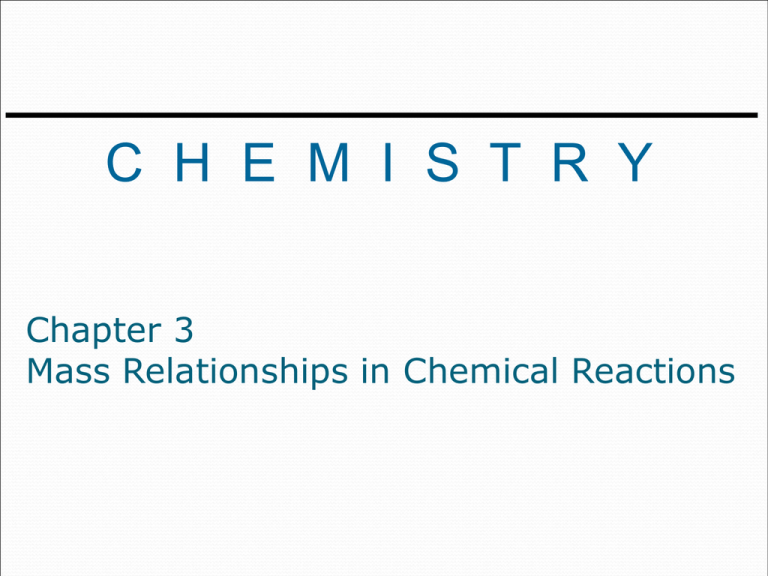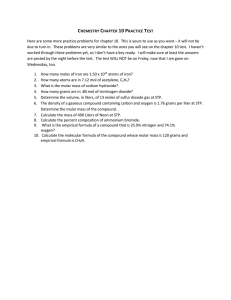
C H E M I S T R Y
Chapter 3
Mass Relationships in Chemical Reactions
Chemical Symbols on Different
Levels
2H2(g) + O2(g)
microscopic:
macroscopic:
2H2O(l)
2 molecules of hydrogen gas react with 1 molecule of
oxygen gas to yield 2 molecules of liquid water.
0.56 kg of hydrogen gas react with 4.44 kg of oxygen gas
to yield 5.00 kg of liquid water.
How can we relate the two to each other?
Avogadro’s Number and the
Mole
Molecular Mass: Sum of atomic masses of all atoms in a molecule.
Formula Mass: Sum of atomic masses of all atoms in a formula unit of any
compound, molecular or ionic.
HCl:
C 2H 4:
1.0 amu + 35.5 amu = 36.5 amu
2(12.0 amu) + 4(1.0 amu) = 28.0 amu
Molar Mass of K3PO4
Calculate the molar mass of K3PO4.
Element Number
of Moles
K
Atomic Mass
Total Mass
in K3PO4
P
O
4
Stoichiometry: Chemical
Arithmetic
Stoichiometry: The relative proportions in which elements form compounds or
in which substances react.
aA + bB
Grams of
A
cC + dD
Moles of
A
Molar Mass of A
Moles of
B
Grams of
B
Molar Mass of B
Mole Ratio
Between A and B
(Coefficients)
Stoichiometry: Chemical
Arithmetic
Aqueous solutions of sodium hypochlorite (NaOCl), best known as household bleach,
are prepared by reaction of sodium hydroxide with chlorine gas:
2NaOH(aq) + Cl2(g)
NaOCl(aq) + NaCl(aq) + H2O(l)
How many grams of NaOH are needed to react with 25.0 g Cl2?
Grams of
Cl2
Molar Mass
Moles of
Cl2
Moles of
NaOH
Mole Ratio
Copyright © 2008 Pearson Prentice Hall, Inc.
Grams of
NaOH
Molar Mass
Chapter 3/6
Stoichiometry: Chemical
Arithmetic
The comercial production of iron from iron ore involves
the reaction of Fe2O3 with CO to yield iron metal plus
carbon dioxide:
Fe2O3(s) + 3CO(g) 2Fe(s) + 3CO2(g)
Predict how many grams of CO will react with 0.500 moles
Fe2O3?
Copyright © 2008 Pearson Prentice Hall, Inc.
Chapter 3/7
Yields of Chemical Reactions
Actual Yield: The amount actually formed in a reaction.
Theoretical Yield: The amount predicted by calculations.
Percent Yield =
actual yield
theoretical yield
x 100%
Reactions with Limiting
Amounts of Reactants
Limiting Reactant: The reactant that is present in limiting
amount. The extent to which a chemical reaction takes place
depends on the limiting reactant.
Excess Reactant: Any of the other reactants still present
after determination of the limiting reactant.
Reactions with Limiting
Amounts of Reactants
At a high temperature, ethylene oxide reacts with water to form ethylene glycol which is
an automobile antifreeze and a starting material in the preparation of polyester polymers:
C2H4O(aq)
+
H2O(l)
C2H6O2(l)
If 3 moles of ethylene oxide react with 5 moles of water, which reactant is limiting and
which reactant is present in excess?
Reactions with Limiting
Amounts of Reactants
At a high temperature, ethylene oxide reacts with water to form ethylene glycol which is
an automobile antifreeze and a starting material in the preparation of polyester polymers:
C2H4O(aq)
+
H2O(l)
C2H6O2(l)
Example
The reaction between aluminum and iron (III) oxide can
generate temperatures approaching 3000oC and is used in
welding metals:
2 Al(s) + Fe2O3(s) Al2O3(s) + 2Fe(s)
In one process, 124 g Al are reacted with 601 g of Fe2O3.
a. Which reactant is limited?
b. What is the theoretical yield of Al2O3(s)?
Reactions with Limiting
Amounts of Reactants
Lithium oxide is used aboard the space shuttle to remove water
from the air supply according to the equation:
Li2O(s) + H2O(g)
2LiOH(s)
If 80.0 g of water are to be removed and 65.0 g of Li2O are available, which
reactant is limiting? How many grams of excess reactant remain? How many
grams of LiOH are produced?
Percent Composition and
Empirical Formulas
Percent Composition: Expressed by identifying the elements present and
giving the mass percent of each.
Empirical Formula: It tells only the ratios of the atoms in a compound.
Molecular Formula: It tells the actual numbers of atoms in a compound. It
can be either the empirical formula or a multiple of it.
multiple =
molecular mass
empirical formula mass
Steps in determine the Empirical
formula
Step 1: Obtain the mass of each element (in grams)
Step 2: Determine the numbers of atom present
Step 3: Divide the smallest moles by numbers of each atoms
to obtain the closet integer as possible.
Step 4: If the result ended with 0.5, 0.33, 1.125, 1.50 etc…
then multiply with a factor to get the nearest integer as
possible.
Example
An unknown sample gives the following mass percent:
17.5% Na, 39.7% Cr and 42.8% O. What is the empirical
formula?
Mass percents
Molar masses
Moles
Mole ratios
Relative mole
ratios
Subscripts
Example
A compound of nitrogen and oxygen is analyzed, and a
sample weighing 1.587 g is found 0.483 g N and 1.104 g O.
What is the empirical formula of the compound?
Examples
Determine the empirical formula of the compound made
when 8.65 g of iron combines with 3.72 g of oxygen..
Percent Composition and
Empirical Formulas
A colorless liquid has a composition of 84.1 % carbon and 15.9
% hydrogen by mass. Determine the empirical formula. Also,
assuming the molar mass of this compound is 114.2 g/mol,
determine the molecular formula of this compound.
Determining Empirical
Formulas: Elemental Analysis
Combustion Analysis: A compound of unknown composition (containing a
combination of carbon, hydrogen, and possibly oxygen) is burned with oxygen to
produce the volatile combustion products CO2 and H2O, which are separated and
weighed by an automated instrument called a gas chromatograph.
hydrocarbon + O2(g)
carbon
hydrogen
xCO2(g) + yH2O(g)
Example
The molecular formula of trioxane, which contains carbon,
hydrogen, and oxygen, can be determined using the data
from two different experiments. In the first experiment,
17.471 g of trioxane is burned in the apparatus shown
above, and 10.477 g H2O and 25.612 g CO2 are formed. In
the second experiment, the molecular mass of trioxane is
found to be 90.079amu.
Example
A compound contains only carbon, hydrogen, and oxygen.
Combustion of 10.68 mg of compound yields 16.01 mg
CO2 and 4.37 mg H2O. The molar mass of the compound is
176.1 g/mol.








